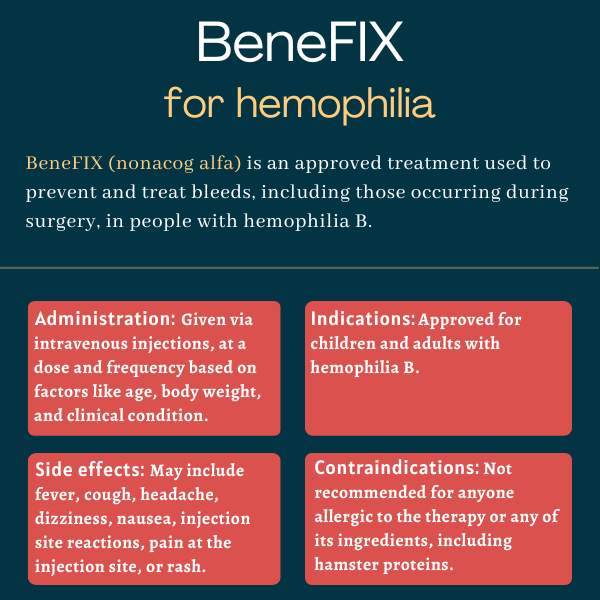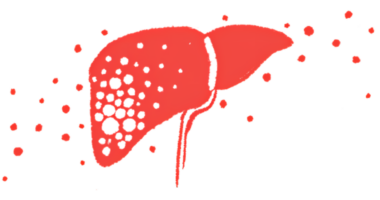BeneFIX (nonacog alfa) for hemophilia
What is BeneFIX for hemophilia?
BeneFIX (nonacog alfa) is a recombinant, or man-made, clotting factor therapy approved to prevent and treat bleeding episodes, including those occurring during surgery, in adults and children with hemophilia B.
The therapy, given via an intravenous (into-the-vein) injection, is marketed by Pfizer.
Therapy snapshot
| Brand name: | BeneFIX |
| Chemical name: | Nonacog alfa |
| Usage: | Prevention and treatment of bleeding episodes, including those occurring during surgery, in hemophilia B patients |
| Administration: | Intravenous injection |
How does BeneFIX work?
Hemophilia B is caused by mutations that result in the lack of functional factor IX, or FIX, a protein important for blood clotting, leading to excessive and prolonged bleeding.
BeneFIX contains a recombinant, or man-made, version of FIX that is structurally and functionally identical to the version of the protein naturally produced in the body. The therapy can thus be administered to people with hemophilia B to make up for the missing protein, thereby restoring normal blood clotting.
It’s manufactured using a genetically engineered Chinese hamster ovary (CHO) cell line, so it may contain traces of hamster proteins.
Who can take BeneFIX?
BeneFIX was first approved by the U.S. Food and Drug Administration in February 1997, becoming the first recombinant FIX therapy to be approved in the U.S. for treating hemophilia B. It’s currently indicated for use in adults and children with hemophilia B as:
- an on-demand treatment to control bleeds
- a perioperative treatment to control bleeds during and after surgery
- a prophylactic (preventive) treatment to reduce the risk of bleeds.
BeneFIX also is approved in the European Union to treat and prevent bleeds in adults and children with hemophilia B.
Who should not take BeneFIX?
BeneFIX is contraindicated, or not recommended, to anyone with a known allergy to the medication or any of its components, including hamster proteins.
The therapy also is not indicated for induction of immune tolerance in hemophilia B patients. This means it should not be used in an attempt to reeducate a patient’s immune system to stop producing neutralizing antibodies (inhibitors) against delivered clotting factors.
How is BeneFIX administered?
BeneFIX is given as an injection directly into the bloodstream, and may be self-administered after appropriate training by a healthcare provider.
It is available as a dry white powder and is supplied as single-use vials that come in five color-coded strengths:
- Yellow is 250 international units (IU) of FIX.
- Blue is 500 IU of FIX.
- Green is 1,000 IU of FIX.
- Red is 2,000 IU of FIX.
- Gray is 3,000 IU of FIX.
The powder must be reconstituted, or diluted, in a supplied liquid solution before it can be administered. The injection usually takes several minutes, and should be adjusted based on a patient’s comfort level. After being reconstituted, BeneFIX should be administered within three hours.
The first doses of the therapy should be given under adequate medical supervision to guarantee patients have access to proper medical care in case an allergic reaction occurs. It should not be administered as a continuous intravenous infusion.
The appropriate dose and duration of treatment will be determined by a healthcare professional based on the patient’s age, body weight, and clinical condition, as well as on the type of bleed, bleeding severity, and degree of FIX deficiency.
When administered as a routine prophylactic treatment, BeneFIX should be given at a dose of 100 IU per kilogram of body weight once a week. This dosing schedule may be adjusted according to a patient’s response to treatment.
For on-demand and perioperative treatment, BeneFIX is recommended to be given to maintain FIX activity levels at:
- 20 to 30 IU/dL, with dosing every 12-24 hours for 1-2 days, in the case of minor bleeds (e.g., uncomplicated joint bleeds or superficial muscle bleeds)
- 25 to 50 IU/dL, with dosing every 12-24 hours for about 2-7 days until bleeding stops and healing begins, in the case of moderate bleeds (e.g., deep muscle bleeds, bleeding resulting from tooth extraction, blood in the urine)
- 50 to 100 IU/dL, with dosing every 12-24 hours for 7-10 days, in the case of major bleeds (e.g., surgery, bleeds occurring in the throat, abdominal cavity, and brain).
Patients wishing to self-administer BeneFIX should follow the specific instructions given by their doctor. Detailed instructions for preparing and administering BeneFIX are available with the prescribing information.

BeneFIX in clinical trials
The efficacy of BeneFIX was demonstrated in clinical trials that included a total of 153 people with hemophilia B.
On-demand treatment
More than 100 patients — 55 who’d previously had treatment and 54 who hadn’t received any treatment — were given BeneFIX on demand as needed to manage bleeds. A total of 1,796 bleeding episodes were reported among previously treated patients, 80.9% of which were resolved with a single injection. In previously untreated patients, 75% of the 997 reported bleeds also resolved with a single injection of BeneFIX.
Across both groups, the response to the first injection was rated as “good” or “excellent” in more than 90% of the patients.
Use in surgery
BeneFIX’s effectiveness at controlling bleeds occurring during surgery also was evaluated. Clinical trials included data on 36 surgical procedures performed in 28 previously treated patients, as well as on 30 procedures in 23 previously untreated patients.
The effectiveness of BeneFIX at controlling bleeds was rated as “good” or “excellent” in 97.1% of the surgeries conducted in previously treated patients and in 96.7% of the surgeries performed in previously untreated patients.
Prophylaxis
In an open-label Phase 3 trial (NCT01335061), 25 people with hemophilia B who had previously received BeneFIX on demand switched to prophylactic treatment with the therapy (100 IU/kg once weekly). During on-demand treatment, patients had a median of 33.6 bleeds per year. After starting BeneFIX prophylaxis, the median annualized bleeding rate dropped to two bleeds per year.
In another Phase 3 study (NCT00364182), 50 patients with moderately severe to severe hemophilia B received prophylactic treatment with BeneFIX at a dose of either 100 IU/kg once a week or 50 IU/kg twice weekly for about four months. With the once-weekly dosing regimen, the mean annual bleeding rate was less than five bleeds a year; with the twice-weekly regimen, it was less then three bleeds per year. Data also demonstrated that both prophylactic regimens reduced annualized bleeding rates by nearly 90% compared with on-demand treatment.
Common side effects of BeneFIX
The most common side effects of BeneFIX reported in clinical trials include:
- fever
- cough
- nausea
- headache
- dizziness
- pain or other reactions at the injection site
- skin-related allergic reactions, such as rash or hives.
Allergic reactions
Allergic reactions, including serious reactions (anaphylaxis), have been reported with BeneFIX. Symptoms of allergic reactions may include rash or hives, facial swelling, coughing or wheezing, dizziness, and generalized discomfort and fatigue.
Patients should be closely monitored for signs and symptoms of such reactions, especially during the initial phases of treatment. If an allergic reaction occurs, BeneFIX should be immediately stopped and appropriate treatment given to manage the reaction.
Development of inhibitors
Sometimes a patient’s immune system will mistake the clotting protein in BeneFIX for an infectious threat and create neutralizing antibodies, or inhibitors, against it. If BeneFIX doesn’t have the expected effect on FIX activity levels or bleed control, tests should be conducted to assess the presence of inhibitors.
Patients who are positive for inhibitors are at an increased risk of experiencing a severe allergic reaction to BeneFIX. For this reason, it’s recommended that patients experiencing an allergic reaction be evaluated for the presence of inhibitors, and that those with inhibitors be closely monitored for potential signs of allergic reactions, particularly in the early phases of treatment.
Blood clotting complications
Potentially life-threatening blood clotting complications have been reported when BeneFIX is administered via continuous infusion into the bloodstream with a venous catheter. The safety and efficacy of therapy administration through this method is not established.
Immune tolerance induction and nephrotic syndrome
There have been reports of nephrotic syndrome, a type of kidney damage, when FIX products like BeneFIX were used for immune tolerance induction — a type of therapy to help eliminate inhibitors — in patients with inhibitors and a history of allergic reactions to FIX. The safety and effectiveness of BeneFIX in immune tolerance induction are not established.
Use in pregnancy and breastfeeding
There are no available data on using BeneFIX during pregnancy or while breastfeeding. Therefore, it’s not known if BeneFIX can be harmful to a developing fetus, pass to breast milk, or have a negative effect on breastfed infants.
In these situations, patients and their care teams should weigh the potential benefits and risks of continuing or stopping BeneFIX treatment.
Hemophilia News Today is strictly a news and information website about the disease. It does not provide medical advice, diagnosis or treatment. This content is not intended to be a substitute for professional medical advice, diagnosis, or treatment. Always seek the advice of your physician or other qualified health provider with any questions you may have regarding a medical condition. Never disregard professional medical advice or delay in seeking it because of something you have read on this website.
Recent Posts
Related articles

 Fact-checked by
Fact-checked by 




